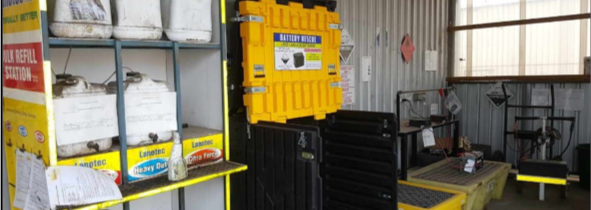Safe and Sound Week is August 12-18, So Let’s Take a Look at Material Handling Battery Safety and how to Avoid Injury.
By MHI Member Company, Green Cubes Technology
Trisha Skarda – Inside Sales and Marketing Coordinator for Green Cubes Technology’s Motive Power Division
The United States Department of Labor has several cases that are related to battery incidents causing bodily harm and injury. Just a few of the cases are titled, “Employee burns hands and arm when contacts battery rack”, “Employee sustains leg fracture when pinned against a battery”, and the most tragic “Employee is struck in head by pallet jack battery and is killed”. These are disastrous and unnecessary accidents that could have been avoided.
In today’s world, safety is of the utmost priority for companies especially within the material handling department. Operating a forklift or pallet jack can be dangerous enough and even more so when it comes to handling the energy storage system used. Adding to this risk includes, swapping the battery multiple times a day, acid and gas hazards associated with lead-acid, and shock.
The most reoccurring area for an incident to occur is battery swapping. There are many problematic areas of concern when an employee swaps out a battery. With regards to lead-acid, the battery could possible need to be swapped out three or four different times in a 24-hour period. These batteries can weight thousands of pounds and should be carefully handled when removing from one piece of equipment and placing on a charger. Most of the time a mechanical lift is used to assist in the swap, as well as, the physicality of the person making the swap. The equipment should have proper maintenance done on a regular basis to avoid any issues that can occur during swapping. The person assisting should make sure they always use proper lifting techniques and be aware of their surroundings.
As shown by one of the cases above, when using the mechanical lift, close attention must be paid when the battery is swapped. If the lift does not have a fail-safe or other safeguards in place; there is a high chance that a person’s body parts could be injured, crushed, or even severed depending on the severity of the incident. All these safety concerns could be completely eliminated by making the change to lithium-ion battery systems. These systems only require one battery per piece of equipment so there is absolutely no swapping necessary. Once these batteries are put in place, they do not need to be moved until it is time to replace them five to seven years down the road.
Other hazards to be aware of are the acid and gas from lead-acid batteries. Lead-acid batteries contain sulfuric acid and if they are not properly maintained, the acid can seep over the sides and leave spills on the floor. If it comes in contact with skin; it has the potential for serious burns that could lead to hospitalization. The spills also create a slip and fall hazard. Excessive gasses that can be caused by numerous issues and formed naturally can lead to battery failure or even worse, small explosive events causing damage to property, facilities, and people. It takes strict maintenance and care to ensure the acid and gas stay at acceptable levels. Battery life can be severely reduced if levels are not kept in check. With a lithium-ion, there is no acid or gassing issues. The batteries do not require maintenance of any kind and contain no harmful chemicals. That alleviates another large safety issue concerning material handling equipment.
Without proper equipment, a lead-acid battery can cause a high-voltage shock. This danger is also present during swapping. Employees handling batteries must not wear metal of any kind as it also carries the risk of electrocution. An employee needs to be thoroughly trained in battery handling and maintenance to try and avoid all dangers.
OSHA incidents can cause bad public relations, loss in money from fines, compensation, and lawsuits, wasted time, lower morale, necessary equipment and/or parts replacements, and a higher turnover rate for a company. Although lithium-ion batteries can be two to three times more expense; the safety factors alone should be enough to investigate making the switch. There are other numerous advantages including: needing less batteries per piece of equipment less often, longer run times, no needed storage room, no PPE or washing stations, and higher productivity.





